A Bestiary of Active Galaxies
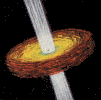

|
|
Gene Smith's Astronomy Tutorial A Bestiary of Active Galaxies |
 |

Radio Galaxies
In the mid-1950s it was discovered that powerful radio sources are frequently associated with giant elliptical galaxies. This was a surprise because galaxies had been thought to be collections of billions of stars along with bits of hydrogen gas and dust. Stars like the sun are not strong radio emitters, nor is the Milky Way a powerful radio source, though there is a weak source, Sagittarius A, at the center. But these gE radio galaxies emit radio energy that outshines the combined light of the hundreds of billions of stars in the galaxy by as much as a factor of 100! The first radio galaxy discovered was Cygnus A whose radio structure, typical of giant radio galaxies, is shown below. The radio emission comes principally from giant radio lobes, well outside the visible portions of the galaxy, sometimes covering several million light-years. Frequently there is also a radio core, coincident with the galaxy nucleus.
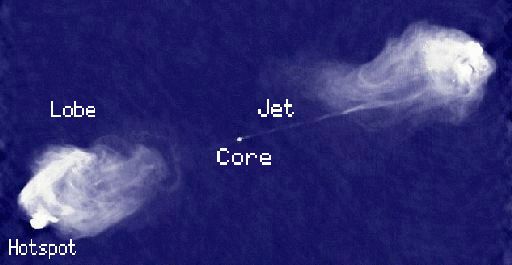
The origin of the radio emission from Cygnus A and other radio galaxies was
soon identified by UCSD's Geoffrey Burbidge as Synchrotron Emission,
light produced by "relativistic" electrons, moving near the speed of light,
spiralling around lines of magnetic force. But many puzzling questions
remained:
| 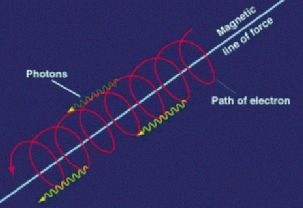 Electrons moving near the speed of light produce Synchrotron Radiation when they are accelerated around lines of magnetic force. |
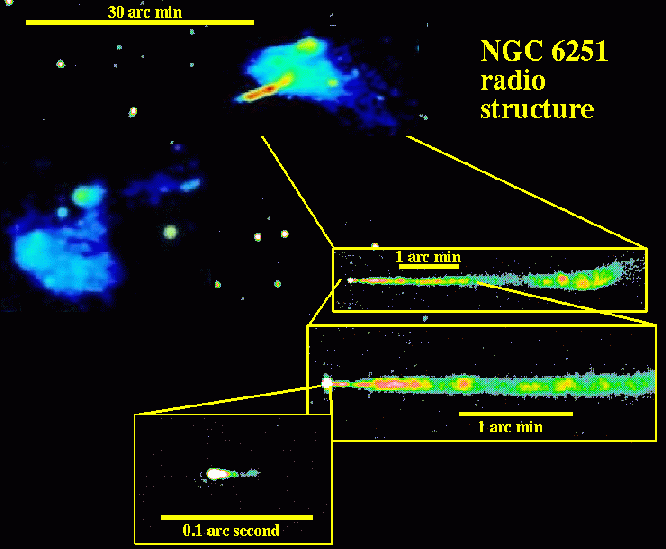
As more detailed radio studies have become available, astronomers have traced the source of radio power back to the galaxy nucleus. These studies show that intense beams or jets, moving with highly-relativistic speeds are transporting the electrons and magnetic field out to the radio lobes. The radio lobes are believed to be produced when the jets ram into intergalactic gas clouds or possibly the interstellar medium of nearby dwarf galaxies. These jets are just like the jets that are believed to be responsible for quasars' super-luminal expansion, except that in this case we do not see them pointed at us. Time dilation, caused by moving at speeds almost equal to the speed of light allows the jets to carry the synchrotron electrons out to the radio lobes before they lose their energy. What is the ultimate source of energy? Most astronomers suspect that, like the quasars, powerful radio galacxies are powered by a massive black hole in the galaxy nucleus.
Seyfert Galaxies
| In 1943, astronomer Carl Seyfert noticed that certain nearby spiral galaxies have very bright, pinpoint nuclei. Spectra of these galaxies, now named Seyfert galaxies, showed that they have unusual spectra with very strong, often broad, emission lines. |
The Bright Nucleus of the Seyfert Galaxy NGC 7742 |
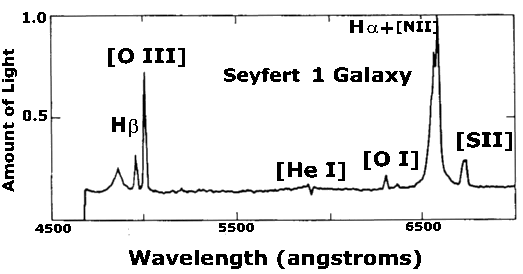
Seyfert galaxies are divided into two classes, based upon the widths of their spectral emission features. The Seyfert 1 galaxy above has hydrogen emission features with very large widths, indicating that the gas in the galaxy's central regions is moving with velocities of several thousand km/sec (Seyfert 1 galaxies show velocities up to almost 0.1c). Compare the Seyfert 1 spectrum with the spectrum of the quasar 3C273, on the previous page. In many respects Seyfert 1 galaxies are like "mini-quasars" and many astronomers believe that Seyfert 1 galaxies are in fact lower luminosity examples of the quasar phenomenon.
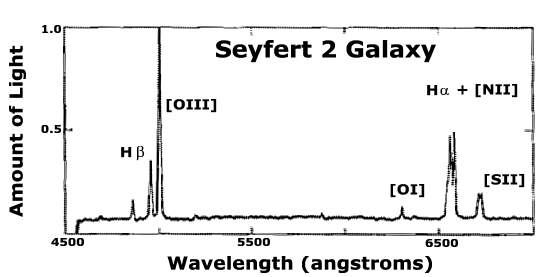
The Seyfert 2 galaxy shown above has much narrower emission features implying much lower velocities (note that the Seyfert 1 above shows narrow features as well).
A Quasar/AGN Model
 Black Hole, Accretion Disk & "Relativistic Jet |
 . Stars which venture
too near the central black hole are ripped apart by tidal forces, falling
inward to form an accretion disk. Which slowly carries material inward
to the Black Hole. Gravitational energy released by the inward spiral of the
material heats the disk to temperatures of millions of Kelvin in the inner
region, which is a strong source of x-rays. Black holes are "messy eaters"
some of the material pulled inward is ejected at velocitiess near the speed of
light along the rotation axis of the Black Hole, producing the jets seen at
radio wavelengths. . Stars which venture
too near the central black hole are ripped apart by tidal forces, falling
inward to form an accretion disk. Which slowly carries material inward
to the Black Hole. Gravitational energy released by the inward spiral of the
material heats the disk to temperatures of millions of Kelvin in the inner
region, which is a strong source of x-rays. Black holes are "messy eaters"
some of the material pulled inward is ejected at velocitiess near the speed of
light along the rotation axis of the Black Hole, producing the jets seen at
radio wavelengths.
|
 Broad-Line Clouds |
|
 HST Image of NGC 4261 |
|
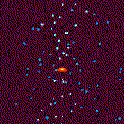 Narrow-Line Clouds |
|
Unification of Quasars and other types of AGN
Many astronomers believe that the different types of Active Galaxies are really all the same type of phenomenon simply seen from different viewing angles with respect to the molecular torus described above.
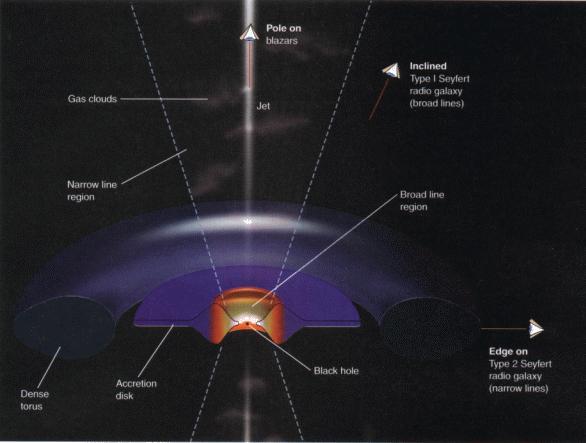

![]() Starbursts & Colliding Galaxies
Starbursts & Colliding Galaxies
![]() Quasars
Quasars
![]() Education & Outreach
Education & Outreach
![]() CASS Home
CASS Home
Comments?
Gene
Smith
Conducted by:
Prof. H. E. (Gene) Smith
CASS 0424 UCSD
9500 Gilman Drive
La Jolla, CA 92093-0424
Last updated: 29 Sept. 2000